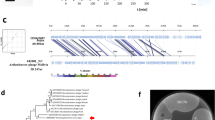Abstract
A killer strain was discovered in cellular slime molds. The wild isolate CK-8 of Polysphondylium pallidum kills all other strains in Polysphondylium and Dictyostelium, as far as could be determined, except strain CK-8 itself and its complementary mating type strain CK-9. Growth-phase cells of CK-8 excrete a killer factor which is sensitive to heat, above 60°C for 5 min, and trypsin. The apparent molecular mass of the factor was determined at 10 000–12 000.
Similar content being viewed by others
Abbreviations
- BSS:
-
Bonner's salt solution
- CM:
-
conditioned medium
References
Bonner JT (1947) Evidence for the formation of cell aggregates by chemotaxis in the development of the slime mold Dictyostelium discoideum. J Exp Zool 106:1–26
Gunge N, Tamaru A, Ozawa F, Sakaguchi K (1981) Isolation and characterization of linear deoxyribonucleic acid plasmids from Kluyveromyces lactis and the plasmid associated killer character. J Bact 145:382–390
Hagiwara H (1984) Review of Dictyostelium mucoroides BREFELD and D. sphaerocephalum (OUD) SACC et MARCH Bull Natl Sci Mus Tokyo Ser B 10:27–41
Hagiwara H (1989) The taxonomic study of Japanese Dictyostelid cellular slime molds. National Science Museum Press, Tokyo
Harrington BJ, Raper KB (1968) Use of a fluorescent brightener to demonstrate cellulose in the cellular slime molds. Appl Microbiol 16:106–113
Ivanovics G (1962) Bacteriocins and bacteriocin-like substances. Bacteriol Rev 26:108–118
Nickerson AW, Raper KB (1973) Macrocysts in the life cycle of the Dictyosteliaceae. II Germination of the macrocysts. Am J Bot 60:247–254
Quackenbush RL (1988) Endosymbionts of killer paramecia. In: Gottz H-D (ed) Paramecium. Springer, Berlin Heidelberg New York, pp 406–418
Preer JR Jr, Preer LB, Jurand A (1974) Kappa and other endosymbionts of Paramecium aurelia. Bacterial Rev 38:113–163
Raper KB (1935) Dictyostelium discoideum, a new species of slime mold from decaying forest leaves. J Agr Res 50:135–147
Saga Y, Yanagisawa K (1982) Macrocyst development in Dictyostelium discoideum. I. Induction of synchronous development by giant cells and biochemical analysis. J Cell Sci 55:341–352
Sonneborn TM (1938) Mating types in Paramecium aurelia: diverse conditions for mating in different stocks; occurrence, number and interrelations of the types. Proc Am Phil Soc 79:411–434
Sussman M (1996) Biochemical and genetic methods in the study of cellular slime mold development. In: Prescott D (ed) Methods in cell physiology, vol 2. Academic Press, New York, pp 397–410
Suzuki K, Yanagisawa K (1989) Environmental factors inducing sexual development in Dictyostelium discoideum. Bot Mag Tokyo 102:51–59
Tipper DJ, Bostian KA (1984) Double-stranded ribonucleic acid killer systems in yeasts. Microbiol Rev 48:125–156
Urushihara H, Yanagisawa K (1987) Fusion of cell ghosts with sexually opposite type cells in Dictyostelium discoideum. Dev Biol 120:556–560
Wickner RB (1983) Genetic control of replication of the double-stranded RNA segments of the killer systems in Saccharomyces cerevisiae. Arch Biochem Biophys 222:1–11
Woods DR, Bevan EA (1968) Studies on the nature of killer factor produced by Saccharomyces cerevisiae. J Gen Microbiol 51: 115–126
Author information
Authors and Affiliations
Rights and permissions
About this article
Cite this article
Mizutani, A., Hagiwara, H. & Yanagisawa, K. A killer factor produced by the cellular slime mold Polysphondylium pallidum . Arch. Microbiol. 153, 413–416 (1990). https://doi.org/10.1007/BF00248419
Received:
Accepted:
Issue Date:
DOI: https://doi.org/10.1007/BF00248419




